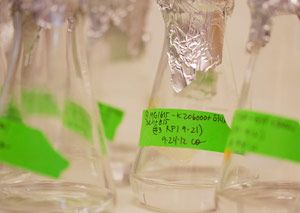Team:UC Davis/Project/Directed Evolution
From 2012.igem.org
(Difference between revisions)
| Line 1,235: | Line 1,235: | ||
<h1>Directed Evolution</h1> | <h1>Directed Evolution</h1> | ||
<article> | <article> | ||
| - | Evolution occurs naturally by selection pressure, but in an overall slow pace. To speed up the process for certain desired traits, it is possible to re-passage cells to grow on a certain type of media, or expose certain mutagens to the cells to select for surviving mutants. Our team has carried out both of these selection pressures in hopes to isolate an ethylene glycol utilizing bacterium. | + | Evolution occurs naturally by selection pressure, but in an overall slow pace. To speed up the process for certain desired traits, it is possible to re-passage cells to grow on a certain type of media, or expose certain mutagens to increase the variation in the cells to select for surviving mutants. Our team has carried out both of these selection pressures in hopes to isolate an ethylene glycol utilizing bacterium. |
</article></div> | </article></div> | ||
Revision as of 15:25, 29 September 2012

Directed Evolution
History
Genome Sequencing
Tecan Experiments


After seeing that ethylene glycol does not pose a threat to MG1655 and DH5a, we subjected the Barcelona strain to the same broad range of ethylene glycol. We sought out to find the most efficient concentration of ethylene glycol for this strain, as a guideline for the efficient concentration of EG for our engineered strain. While analyzing the data, we realized that we have to define efficiency more clearly. Efficiency can mean faster growth on low amounts of ethylene glycol or it could mean a higher optical density after a certain amount of time, where it reaches the stationary phase. We saw that once the ethylene glycol concentration reaches a certain threshold (49.34 mM), the growth curves are all the same in terms of time when the stationary phase has been reached. We saw that some of the E. coli were efficient at low concentrations, making us focus on the fast growth efficiency at lower concentrations of EG because the LC-cutinase will not degrade quickly enough to produce 49.34 mM in a cell’s solution. Now, we have an ongoing experiment where we re-passage cells between ethylene glycol media at 30 mM. We discuss this in more detail in our directed evolution section.
References
2. Andrianantoandro, Ernesto, Subhayu Basu, David K. Karig, and Ron Weiss. "Synthetic biology: new engineering rules for an emerging discipline." Nature - Molecular Systems Biology. (2006): n. page. Web. 29 Aug. 2012.
 "
"















